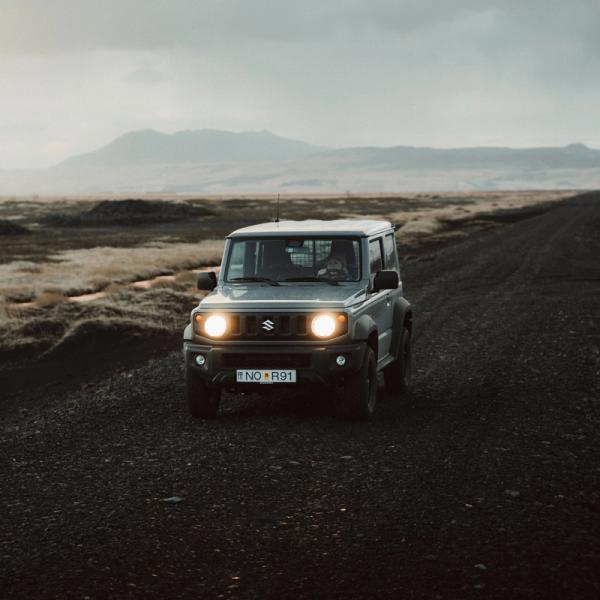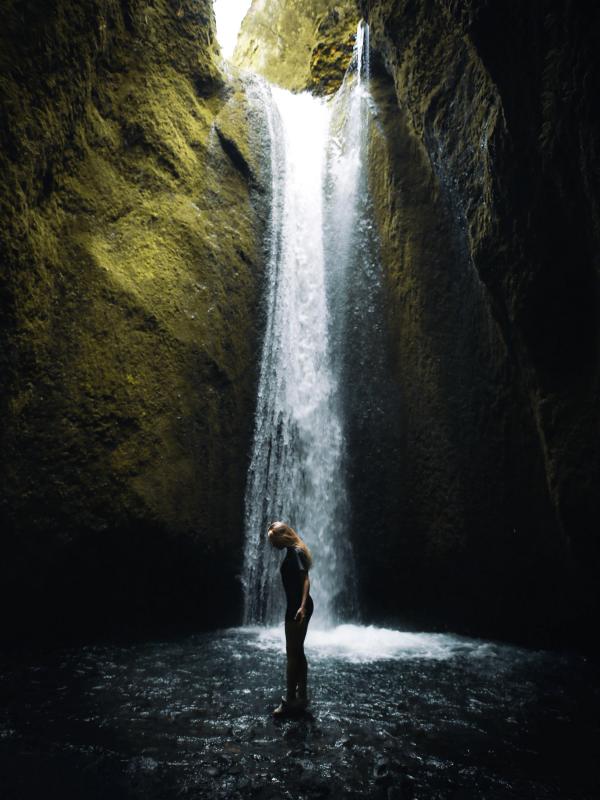
Nauthúsagil Canyon: Complete Travel Guide to the Hidden Waterfall
Most people drive right past Nauthúsagil without even knowing it's there. This moss-covered canyon sits just off the road to Seljalandsfoss, but it's completely different from your typical Iceland waterfall visit.
Here's the thing - you can't just walk up and take photos. Getting to the waterfall means you're gonna wade through streams, climb over wet rocks, and use metal chains to get past a small waterfall. It's actually an adventure.
The canyon is pretty wild-looking. Bright green moss covers its dark walls, and trees grow right across the top. You're walking through natural tunnels everywhere. When light sneaks through, everything just glows green. Really cool stuff.
Best part? It fits right into any South Coast trip. You're already driving this way to see Seljalandsfoss and Skógafoss anyway.
Nauthúsagil Canyon at a Glance
Nauthúsagil strikes a perfect balance. Most Iceland stuff is either a super easy walk or a crazy, serious hike where you need special gear. This one's right in the middle: challenging enough that you feel like you actually did something, but totally doable for regular hikers.
What makes it so cool is how close everything gets. You're not standing way back looking at a waterfall from some viewing platform. You're literally climbing right past it. The walls close in around you, trees overhead making it feel like you're walking through a green tunnel. It's nothing like those typical selfie spots.
Location-wise, it's perfect. If you're hitting Seljalandsfoss anyway, this only adds maybe 90 minutes to your day and gives you this incredible story that most people miss.
Key Facts:
- Distance from Reykjavík: 140 km (takes about 2 hours)
- Hike length: 1.5 km round-trip
- Time needed: 45-90 minutes
- Difficulty: Easy walking, but you've got wet rocks and a one-chain climb
- Cost: Free parking, free access
- Best time: May through September
- Car needed: A Regular car is totally fine in summer
What you'll actually be doing:
- Wading across streams on stepping stones
- Climbing a 2-meter waterfall using metal chains
- Walking to this hidden waterfall tucked in a narrow spot
- Going under this tree canopy
- Dealing with slippery rocks that are covered in moss
Good to know:
- There's literally nothing nearby - no bathrooms, no food, nothing
- Cell service just doesn't work inside
- You're gonna get wet (waterproof boots are a lifesaver)
- Skip it if you've got any mobility issues
- It's part of the Katla Geopark (official geological site)
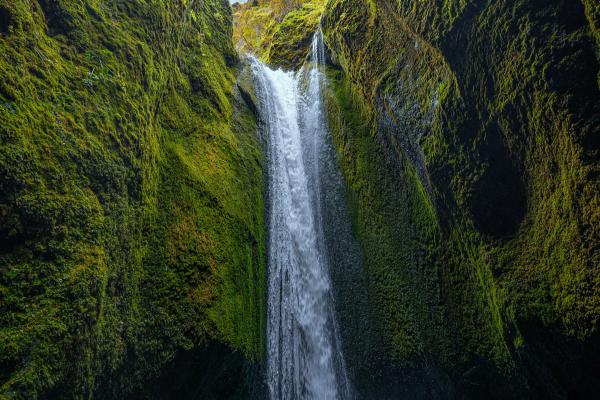
When to Visit Nauthúsagil Canyon
Getting your timing right makes a huge difference. Mess this up, and you could encounter closed roads, icy conditions, or water levels that make the whole experience dangerous.
Best Season
May through September works for most people. The road stays open to regular cars during this time, there's no snow messing up the trail, and the moss looks bright green.
July and August are your best bet, though. You get almost 20 hours of daylight during peak summer, the waterfall flow is really strong from all that snowmelt, and the trees are fully green. That's when you get that thick tree cover.
Late May can be great if you want way fewer people around. Everything turns green, but the hills stay brown, which looks good in photos. Just check road conditions first because spring weather in Iceland can be totally unpredictable.
September's good too. You still get decent weather, but way fewer tour groups clog things up. Plus, you might catch some fall colors. After October, though, daylight hours drop super fast, and the weather gets pretty sketchy.
Don't even think about winter unless you're really, really experienced. The canyon can freeze completely solid. You get beautiful ice formations, but they're also extremely dangerous. Plus, the gravel road leading there becomes almost impossible without some serious 4x4 gear.
Best Time of Day
Go early morning, before 9 AM, and you'll have the whole place to yourself. Tour groups from Reykjavík don't usually show up until mid-morning, so you can take your sweet time on the chain part without people breathing down your neck.
Late morning, around 10-11 AM, is excellent for photos when the sun is at a just-right angle. Light filters through the trees, illuminating all the moss. But yeah, you'll definitely get more crowds.
Evening visits work great in summer too, especially after 6 PM when you've still got hours of light left. The light gets soft, crowds thin out. Just make sure you've got enough time to hike back out before it gets dark.
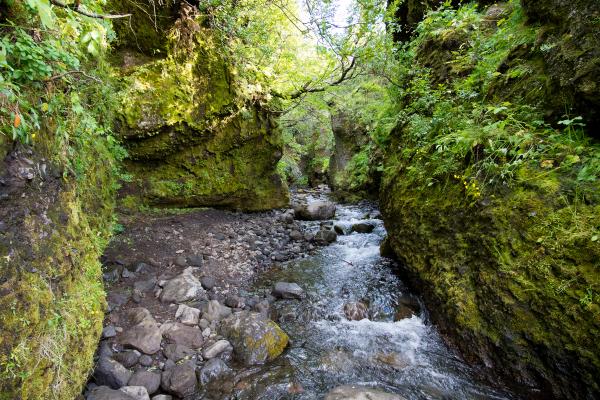
Getting to Nauthúsagil Canyon
Getting there is way easier than you'd think for such a hidden spot. You just follow the exact same route you'd take to Seljalandsfoss, then keep going a little further on gravel.
Driving There
From Reykjavík, take the Ring Road (Route 1) east for about 120 km. You'll see signs for Seljalandsfoss, and that's where you take a left onto Route 249. Takes about 2 hours if traffic's normal.
Stay on Route 249 past both Seljalandsfoss and Gljúfrabúi. The road switches from pavement to gravel and becomes F-249. Don't freak out, though; this first section is totally fine for regular cars in summer. The real gnarly 4x4 stuff doesn't start until you get closer to Þórsmörk.
After about 5 km on gravel, keep an eye out for a small parking area on your right. There's a Katla Geopark sign, but no big "Nauthúsagil" sign or anything. Super easy to miss if you're not paying attention. If you suddenly hit river crossings, you've gone too far.
Car situation: Any regular car works perfectly from May through September. Yeah, the F-road name freaks some people out, but the section to get to Nauthúsagil is manageable. The real challenging stuff starts way further up the road.
Parking
Parking's free, and you don't need any permits or anything. The gravel lot may fit 20 cars, but honestly, it's almost never full. If you need to, you can park along the road, just don't block any farm gates.
It's so much simpler than Seljalandsfoss, with all that paid parking and tour buses everywhere. Here, you literally just show up and go.
Tours
Some companies throw Nauthúsagil into their super-jeep tours heading to Þórsmörk. These work well if you want to see the Highlands but don't want to deal with river crossings yourself. Plus, the guides actually know all the geology stuff and local stories.
Some local operators around Hvolsvöllur do shorter trips that focus just on Nauthúsagil and the nearby spots, too.

What the Hike's Actually Like
This is definitely not your typical Icelandic nature walk. You're gonna get your hands dirty. Like, literally dirty. The hike mixes super-easy parts with genuinely tricky bits that require your attention and basic scrambling skills.
The Route
The whole hike's about 1.5 km round-trip with maybe 60 meters of elevation. Sounds totally easy on paper, but those numbers really don't tell you the whole story. You're not walking on some nice, maintained trail; you're dealing with stream beds, wet rocks, and narrow passages where you're squeezing through.
From the parking area, a clear path leads to the canyon entrance. The first 10 minutes feel completely normal: decent footing, obvious route, nothing tricky at all. Then you actually enter the gorge, and everything changes.
Inside the Canyon
Once you're in Nauthúsagil proper, you're basically hiking in the stream or right next to it the whole time. The canyon walls just close right in around you, covered in a bright green moss that makes the place famous. Trees arch overhead, making natural tunnels that filter all the light.
The water stays pretty shallow, usually just ankle to calf-deep, but every single rock underneath is slick with moss and algae. Each step becomes a whole balance challenge. You really gotta take your time and test each step before you commit.
About halfway through, you hit the technical part. There's a small waterfall that blocks the stream, and you've gotta use fixed metal chains to climb around it. This 2-meter climb is the tough bit of the whole thing; it's not hard if you're comfortable on wet rocks, but it can be pretty scary if you're not.
Only one person should use the chains at a time. The rocks are wet from all the spray, so every single handhold and footstep needs your full attention. Most people who hike regularly handle it just fine, but it's definitely not good for kids or anyone with mobility issues, scared of heights, or who gets uncomfortable with any exposure.
Once you get past the chains, it's just a short walk to the main waterfall. This hidden cascade drops about 20 meters into a narrow chamber surrounded by moss-covered walls. Mist fills the air, and honestly, it's pretty impressive.

Staying Safe at Nauthúsagil
The combination of water, slippery surfaces, and being in this remote location creates hazards you just won't find at Iceland's more developed tourist spots. But a few smart precautions keep everything fun instead of dangerous.
Dealing with Slippery Conditions
Everything in Nauthúsagil is slippery. And I mean everything. The moss-covered walls, the stream rocks, the metal chains, all of it stays wet and slick. You gotta move slowly and test every single step.
When you're crossing the stream, don't rush between stepping stones. If a rock shifts or feels at all unstable, just back off and find a different route. Getting wet feet is way better than taking a hard fall onto sharp rocks.
For the chain section, make sure you wipe your hands clean before grabbing the metal. Muddy or wet palms slip off easier than you'd think. Try to always keep three points of contact: either two hands and one foot, or two feet and one hand.
Weather Changes
The weather in this part of Iceland, like in the whole country, changes fast. Morning sunshine can turn into driving rain within an hour. Always bring waterproof gear, even if the forecast looks perfect.
Don't even attempt Nauthúsagil during or right after heavy rain. The narrow canyon can flood quickly, and water levels can rise several feet in a matter of minutes. If you hear rushing water getting louder while you're in the gorge, head for higher ground immediately.
Emergency Planning
Cell service inside the canyon ranges from weak to nonexistent. Don't count on being able to call for help if something goes wrong. Travel with other people when you can, and tell someone your plans if you're going solo.
The nearest hospital is all the way back in Reykjavík, about 2 hours away. Emergency response to remote locations like this takes time. Prevention beats rescue.
Bring basic first-aid supplies for cuts and scrapes. The wet, rocky environment creates plenty of opportunities for minor injuries that could get serious without any treatment.
Protecting the Environment
Nauthúsagil sits in a fragile highland ecosystem. Stick to the established paths to avoid damaging moss and plants that take decades to recover in Iceland's harsh climate.
Don't try to climb any higher than the obvious safe routes. There are loose rocks and unstable edges that create dangers, plus rescue operations end up damaging the environment you came to enjoy.
Pack out all trash - including stuff like banana peels and other organic waste. Things that rot quickly in other places take longer in Iceland's cold conditions.
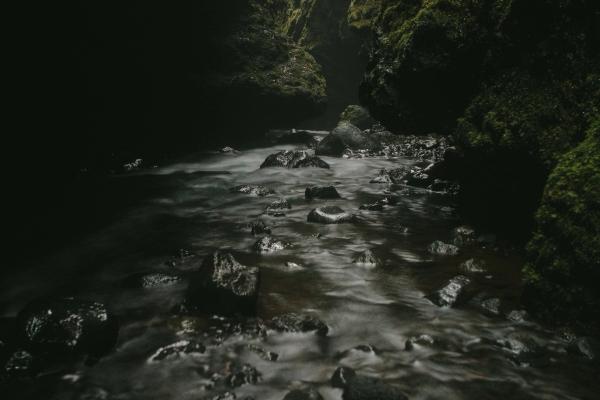
What to Pack
Getting your gear right makes the difference between having an amazing time and being miserable. You're gonna face wet conditions, slippery rocks, and changing weather - sometimes all at the exact same time.
Footwear
- Waterproof hiking boots with a good grip work best
- Stream crossings and moss-covered rocks will push your footwear harder than most Iceland hikes
- Some people bring lightweight water shoes for the stream sections
- Good hiking boots usually handle everything fine if you don’t mind them getting wet
- Running shoes or casual footwear are a bad idea; slipping here can have serious consequences
Clothing
- The canyon stays cooler because of its depth and constant moisture
- Even in summer, you want layers and a waterproof shell
- Waterproof pants aren’t essential, but they definitely help if you’re sitting on wet rocks or wading deeper sections
- At a minimum, bring quick-dry hiking pants that won’t stay soggy all day
- Waterfall mist can soak you quickly, so a spare dry shirt in your pack helps prevent hypothermia if you get drenched
Camera Gear
- Constant moisture makes keeping gear dry the main challenge
- Bring plenty of lens cloths, as fogging is basically guaranteed near the falls
- A polarizing filter cuts glare on wet surfaces and makes the moss colors pop
- Wide-angle lenses work best in the tight canyon spaces
- Waterproof covers or even plastic bags help protect gear from unexpected splashes
Other Essentials
- Small first aid kit with bandages and blister treatment — wet boots create hot spots fast
- Headlamp for emergency use, especially when daylight hours shrink
- Spare socks and a towel left in the car make the drive home so much better after a wet adventure
- High-energy snacks and extra water; the tricky terrain burns energy faster than the distance suggests

Taking Photos at Nauthúsagil
Nauthúsagil creates some of Iceland's trickiest shooting conditions. You've got dim light, constant mist, and a contrast between dark walls and bright water that challenges even the best camera. But if you approach it right, you can turn these problems into opportunities.
Camera Settings
The contrast between the deep shadows and bright water pushes most cameras past their limits. Shoot in RAW format if you possibly can: you're gonna need all the flexibility for shadow recovery and highlight protection later.
For waterfall shots, try shutter speeds between 1/4 and 2 seconds to get a smooth water effect. The canyon's natural low light often makes this possible without any filters.
Expect to bracket your exposures or use HDR mode. The range between the dark moss-covered walls and bright sky way up top often exceeds what any single shot can handle.
Protecting Your Gear
Constant moisture can kill electronics quickly if you're not careful. Keep your equipment sealed tight when you're not actively shooting.
Lens hoods help deflect some of that spray, but don't rely on them. Clean cloths are essential - bring several and keep them dry.
During the chain climb, secure your camera inside your pack. Swinging gear throws off your balance and can get damaged on the rocks.
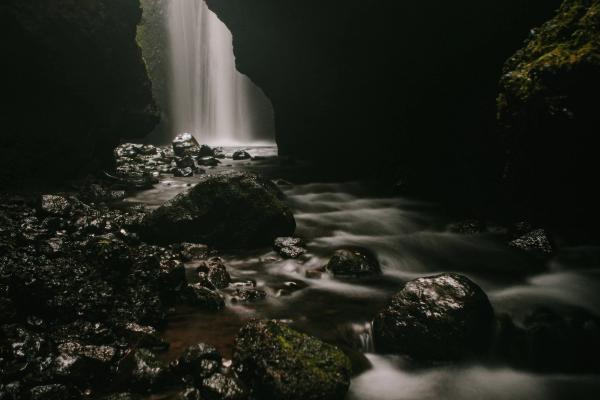
Nearby Attractions
Nauthúsagil's location makes it perfect for combining with other South Coast favorites. You're already driving past several famous waterfalls anyway, so some smart planning gets you more bang for your buck.
Seljalandsfoss & Gljúfrabúi
These two sit just 10 km back down the road from Nauthúsagil. Seljalandsfoss has that classic "walk behind the waterfall" thing, while Gljúfrabúi hides in a narrow grotto where you gotta wade to reach it.
Pro tip: Hit Nauthúsagil early when it's empty, then visit the famous falls on your way back out. The tour buses typically roll up around 10-11 AM.

Skógafoss and Kvernufoss
Keep heading east another 30 km to reach Skógafoss, one of Iceland's most powerful waterfalls. The contrast between its thundering power and Nauthúsagil's intimate scale creates an interesting variety.
Don't miss Kvernufoss either (it's hidden behind the Skógar Museum). You can walk behind this waterfall too, but with way fewer crowds than Seljalandsfoss.
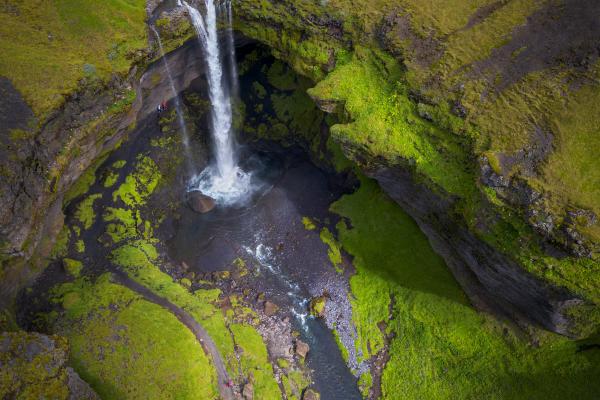
Þórsmörk Valley
For those with 4x4s or joining tours, Þórsmörk offers some good highland hiking. Several operators run day trips from the Seljalandsfoss area.
Stakkholtsgjá canyon, deeper in Þórsmörk, gives you another slot canyon experience that's similar to Nauthúsagil but on a much bigger scale.
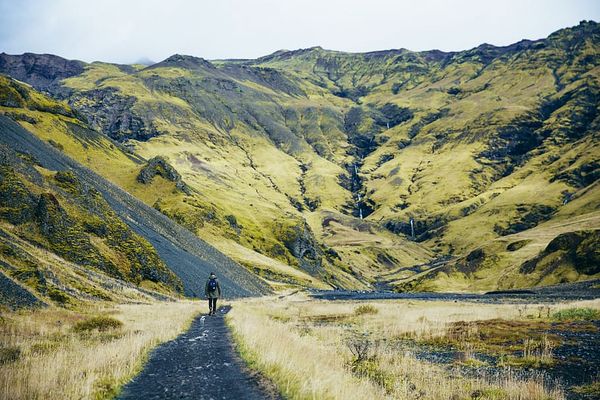
Sample Day Schedule
Here's how a typical South Coast day combining these spots might look:
- 8:00 AM: Leave Reykjavík
- 10:00 AM: Nauthúsagil (beat those crowds)
- 11:30 AM: Seljalandsfoss and Gljúfrabúi
- 1:00 PM: Lunch break in Hvolsvöllur
- 2:30 PM: Skógafoss and maybe Kvernufoss if you're feeling it
- 4:00 PM: Either keep going east or start heading back
This schedule gets you the most out of your day while avoiding the worst crowds.
Practical Details
All the practical stuff matters more at remote spots like this, where there's zero infrastructure. Planning ahead prevents minor problems from becoming major ones.
No Facilities
Nauthúsagil has zero amenities: no bathrooms, no food, no services, nothing. Plan accordingly by using the facilities at Seljalandsfoss before or after your visit.
The closest services are way back in Hvolsvöllur, about 30 km away. Gas stations there have bathrooms, food, and basic supplies.
Free Access
Unlike many Icelandic attractions that charge fees now, Nauthúsagil is free. No advance reservations needed, you just show up and hike.
This could change as the spot gets more popular, though, so enjoy this simple access while it lasts.
Cell Service
Mobile coverage inside the canyon ranges from weak to nonexistent. Download offline maps before you even leave Reykjavík, and mark the parking area's location so you can find it easily on the way back.
In emergencies, you might get some signal by climbing out of the canyon, but don't count on immediate communication.
Geopark Status
Nauthúsagil lies within the Katla UNESCO Global Geopark, which is recognized for its outstanding geological features. There are information boards at the trailhead that explain how these rock formations developed over thousands of years.
Understanding all the geological background makes what you're seeing more interesting - from the layered walls to the moss ecosystems that are thriving in this moist environment.
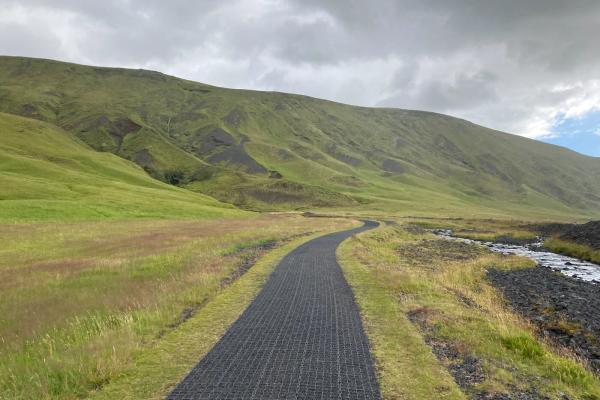
The Story Behind Nauthúsagil
Every Icelandic landmark has stories that go deeper than just scenery. Nauthúsagil's got tales of farming, folklore, and sacred trees that put what you're seeing into context.
Where the Name Actually Comes From
"Nauthúsagil" means "Bull Shed Ravine" in Icelandic. Farmers from the nearby Stóra-Mörk farm used to build livestock shelters right near the canyon entrance. All that lush grass around the gorge provided excellent grazing for cattle and bulls.
The original buildings are gone now, but the name stuck, connecting modern visitors to centuries of farming tradition in this valley.
Ghost Stories
Local legends tell some dark tales about this area. According to folklore, a farmstead called Nauthús was abandoned in 1777 due to severe hauntings.
The story involves three brothers and their sister. Two of the brothers ended up murdering their virtuous sibling, which triggered supernatural revenge that forced the whole family to flee. Whether you believe stories like that or not, they add some intrigue to the canyon's atmosphere.
The Sacred Tree
Nauthúsagil used to host one of Iceland's largest rowan trees, which was considered sacred by local tradition. This massive tree had a trunk over 1.5 meters across, and people believed it would bring bad luck to anyone who harmed it.
That ancient tree fell during a big storm in 1937, but portions of it are preserved at the Skógar Museum. Its descendants still arch across parts of the canyon, creating that canopy that makes Nauthúsagil so photogenic.
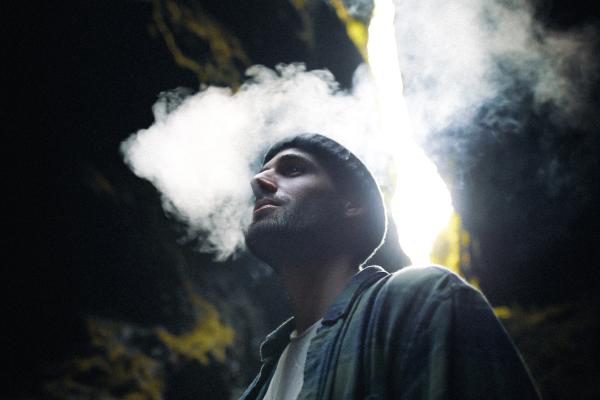
Conclusion
Nauthúsagil gives you everything you want from an Iceland adventure - natural beauty, challenge, and that feeling of discovering something most people miss. This moss-covered canyon combines easy access with real adventure, setting it apart from typical tourist stops.

